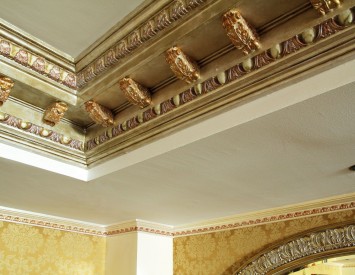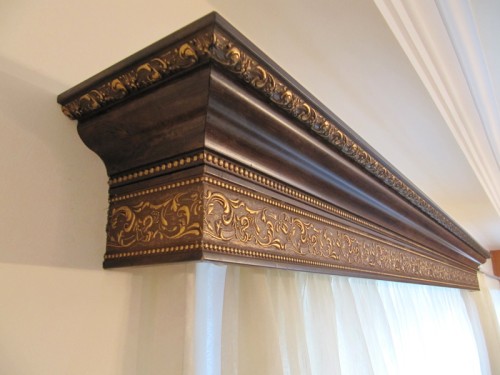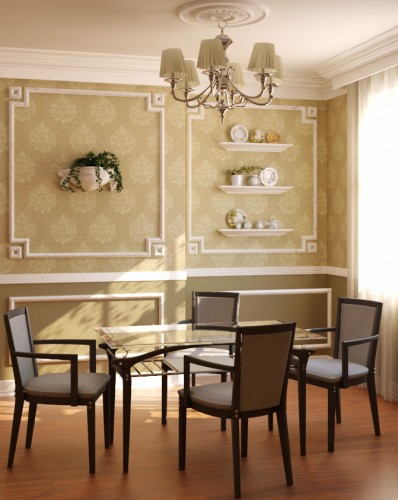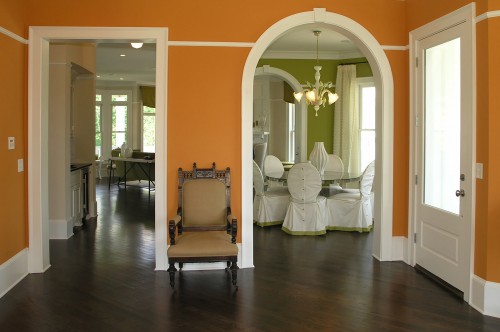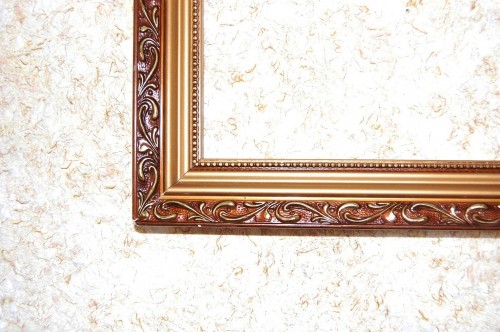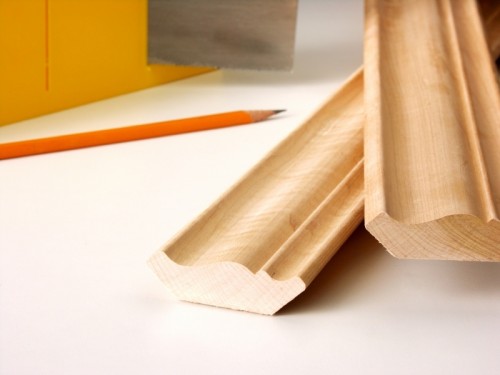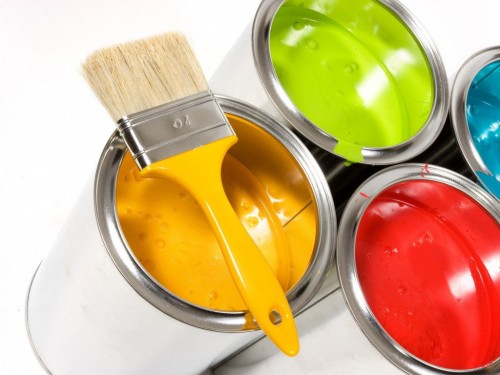Modern trends in the world of design and decor of the dwelling are developing rapidly and more and more finishing materials appear on sale. One of these was the molding (translated from English - “cast detail”) - the overhead bar, as a rule, is convex, which has transverse sections. The initial purpose of this product consisted in protecting the surface of the wall from destruction under the influence of the severity of the furniture. Then the use of this element has gained a wider spectrum.
Content
The use of molding
Today, the functions of molding are decorating the premises, zoning, as well as protecting the surface from various kinds of mechanical damage. Using this element, you can diversify the decor of the doors, walls, ceiling, fireplace. In general, such functions of the molding can be distinguished:
- He is able to transform the interior, give the room a stylish and exquisite look.
- Using this material, you can divide the surface of the wall into separate sections.
- Applying the molding, you can create rectangular, square, round shapes. The space, thus, will be divided into zones, each of which will have a certain purpose. For an additional effect, each section can be painted in a separate color.
- In addition, such a detail can disguise poor -quality finishes or non -aesthetic interior elements.
- Molding as skirting boards will protect the finish, create a complete transition and make the appearance of the room more accurate.
Moldnig also calls the framework for mirrors, cornices, skirting boards, paintings for paintings. The cornices can be different in width, reaching several tens of centimeters, as well as have the most diverse shape. They are:
- stucco;
- convex;
- concave.
Using such a detail in the interior, you can visually change the size of the room. The cornice painted in a shade with the walls will visually raise the ceiling. If it is necessary to achieve the opposite effect, then in one color scheme there should be a cornice and ceiling, and the walls have another palette.
Potts made of wood and plastic are popular. However, it is possible to use wood molding only if absolutely even walls. But the plastic product can be adjusted to the shape of the surface. If there is tiles in the room, then a successful combination will be a molding of similar material. Also, using molding, you can mask the joint between the window and the wall. The window acquires a more complete and expressive look. Mostly in this way they finish the outside of the room.
Doors framed by molding will also look spectacular. Its direct purpose in this case is to hide the joint between the wall and the door box. In addition, the product also performs a decorative function. In this case, it is necessary to choose molding in this case from the same material from which the door is made.
Molding photo:
A successful solution would be molding as a decor. This product can be replaced by stucco molding. Due to its sufficiently high cost, the interior decoration in this way is not available to everyone. In addition, there are few masters in this area. Using the molding, you can decorate the room with stucco details for every taste, as well as hide the irregularities of the walls, the asymmetry of the room, to mask pipes and risers.
Another original way to use this element is the creation of such a designer highlight as a fake. To do this, murals are glued to the wall, glass is attached on top, then molding. As a result, an imitation of a window with a beautiful landscape is obtained. How much it costs to paint the molding in this case to depend entirely on the designer idea of \u200b\u200bthe author.
Materials for the manufacture of molding
A wide variety of materials are used for the manufacture of moldings, among which such as:
- marble;
- gypsum;
- metal;
- polystyrene;
- tree.
Each type of material has its own characteristics. Gypsum is a natural raw material, but you need to consider that it crumbles and is afraid of moisture. Also, in order to install stucco molding from gypsum, you need to contact a specialist, which will significantly affect the cost.
Polyurethane and polystyrene are varieties of foam. The first consists of almost invisible granules, the second - of more pronounced. These materials have an advantage in price, they can be set on their own. When choosing any of the options, you should pay attention to ensuring that it does not crumble and has a homogeneous surface. Polyurethane is the most used material. It is easy to stain in any shade suitable for the interior.
In the manufacture of molding, wood is often used. The most popular breeds used to create decorative elements:
- poplar;
- alder;
- spruce;
- oak;
- mahogany;
- yew;
- maple.
A tree will help create a classic aristocratic style, this type of material is durable and is quite easy to process. But it has a high cost, and also does not have sufficient moisture resistance.
The originality of the room will be made by colored moldings. With their help, you can reproduce the structure of natural wood, also plant and floral motifs, create a variety of geometric patterns. The correctly selected color of the product will advantageously emphasize the design of the room. In addition, it will not be difficult to paint a mirror of polyurethane.
Molding, so that it has an attractive appearance and good safety, must be painted. This prevents the pores of dirt into the pores, and the product itself becomes easier to care for. If necessary, it will not be difficult to wash with any detergent. Even if the desired color is white, it is still necessary to paint the molding.
The necessary materials for the implementation of the process:
- Paint for this product.
- Moldings are polyurethane.
- Decorative plaster.
- Acrylic -based primer.
- Small brush and spatula.
Choose paint
Before dyeing the molding and choosing the optimal coloring composition, the following recommendations should be taken into account:
- To process such an element, latex, water -based, acrylic and mosaic paints are suitable.
- You can also use decorative plaster, the use technology of which has no differences from the application of paint.
- Do not use oil substances, since it will take a lot of time to dry, they do not differ in environmental purity and are inferior in decorative indicators of other types of compositions.
Step -by -step instructions for the coloring of molding
In order to create an original and aesthetic design of the home, it is necessary to prepare a sketch, attach molding and paint it in accordance with certain requirements. So, the methodology of this process looks as follows:
- At the first stage, we select the necessary palette. The initial shade of polyurethane product on the ceiling will have a gray color. If the desired color is white, in this case a little yellow should be added to the white paint. It will also be successful to look like products painted with a small addition of the color of the walls close to the shade of the walls.
- Next, we glue the molding to the surface of the wall. This should be performed on an existing decorative coating - wallpaper, paint, plaster. Otherwise, the polyurethane element will not hold.
- For gluing, you need to use two types of glue. The first is a special composition for fastening the product itself. It has the ability to penetrate the material quite well and provide a strong connection. The second type is designed to process joints between the elements.
- In the process, it should be noted that glue for molding has quite strong properties, gluing occurs almost instantly. Then, in the case of any error, the product is no longer possible to fit in the required direction.
- After decorative elements are glued, you should pay attention to the joints. First, process them with the second type of adhesive composition. Then the edges need to be fucked and packed, using an acrylic -based putty for this. Particular attention should be paid to this stage of the process, since after applying the paint even small roughnesses will become noticeable.
- Next, apply a primer. Choose this material based on acrylic. Such a primer has the ability to penetrate deep into the pores of the product. If we work with porous material, such as polyurethane, this feature is quite relevant. Only subject to the full filling of pores, the paint will fall well on the base.
- After that, using the painting brush, proceed to staining the molding. Learning how to paint polyurethane molding, pay attention to the thickness of the layer. When painting, the substance should be applied with a dense layer, since in this case the surface becomes more embossed.
- At the final stage, using a small spatula, we cover the product with decorative plaster. For fragments from polyurethane, the best option would be to cover with the effect of gold or mother of pearl.
- Also for the final finish I will approach special paint compositions. Their use will imitate the surface of the old tree, weathered stone, gold, etc.
The use of molding will provide an opportunity to arrange an apartment or house with minimal costs and get the maximum effect. Using this element, you can visually create the effect of palace stucco molding, hide unsightly areas of the walls of the walls, visually “raise” the ceiling or, vice versa, make it below. The spectrum of use depends only on the boundaries of fantasy.
The technology of painting relief finishing materials in the style of "dry brush" is presented in the video:
